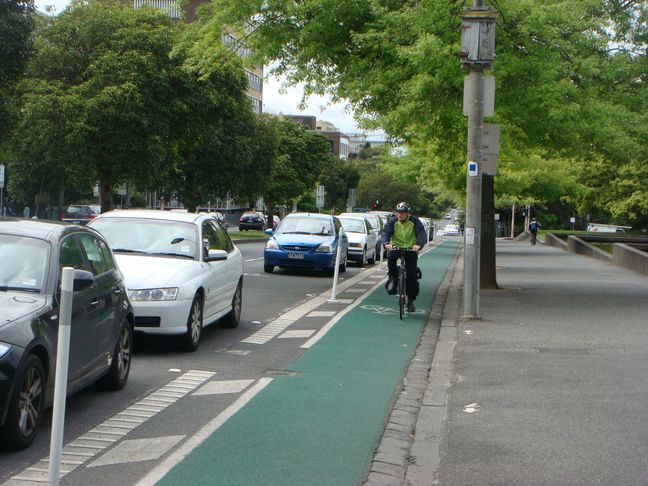Melbourne conference emphasises separated cycling facilities
 ViaStrada director Andrew Macbeth attended the Bike Futures conference in Melbourne in October 2011. The preceding afternoon included a number of technical tours, including the impressive City of Yarra, where significant improvements have been made for cycling over recent years. Here is the conference programme.
ViaStrada director Andrew Macbeth attended the Bike Futures conference in Melbourne in October 2011. The preceding afternoon included a number of technical tours, including the impressive City of Yarra, where significant improvements have been made for cycling over recent years. Here is the conference programme.
A significant theme through the conference was the strong interest in separated bicycle facilities (SBFs), where people can cycle on roads, but be physically separated from motor vehicles.
At left is Albert St, where a protected cycle lane is delineated by flexible bollards, a painted buffer, a textured paint line and parked cars. The lane is wide enough to allow overtaking of one cyclist by another.
Another example of a separated bicycle facility (SBF) from Melbourne is shown below. Swanston St features an island (left) and double back-to-back kerbs (right) to separate cyclists from motor vehicles.
There seems to be an international trend to provide separated bicycle facilities (SBFs) on streets; or paths in parks, along coastlines, on riverbanks or railway corridors to help less confident cyclists cycle in the city. This was apparent in Copenhagen last year and again in Melbourne. ViaStrada has planned and designed SBFs (for example in Christchurch), so don't hesitate to contact us if this seems like the way forward for your city.
A second theme emerging internationally is that speed management is imperative to encourage the many people who want to cycle, to choose to do so. Many parents won't let kids cycle to school or in their neighbourhoods while traffic travels at current speeds on residential streets, so bringing speeds down below 30 km/h is going to be imperative.
The third key to growing cycling in urban areas is leadership, both political and technical. The Bicycle Futures conference in Melbourne had a good representation of political leaders. Widespread introduction of SBFs in New York in recent years have depended on strong technical and political leadership.
These three themes are connected. Traffic engineers and civic leaders sometimes wonder what cycle facilities could be provided to support cycling. But thinking about cycling infrastructure is perhaps too narrow a brief. Cycling infrastructure is important; so too is making the entire road network safer for cycling, with speed reduction the main tool. However, having a supportive political and cultural environment for cycling is paramount to increasing cycling in our urban areas.


